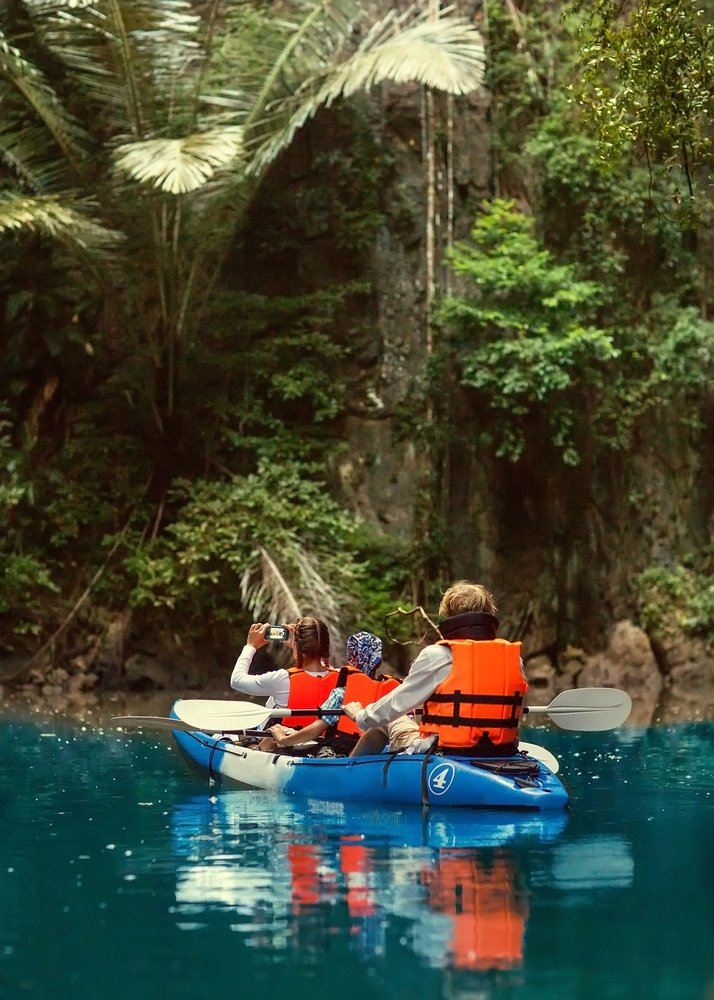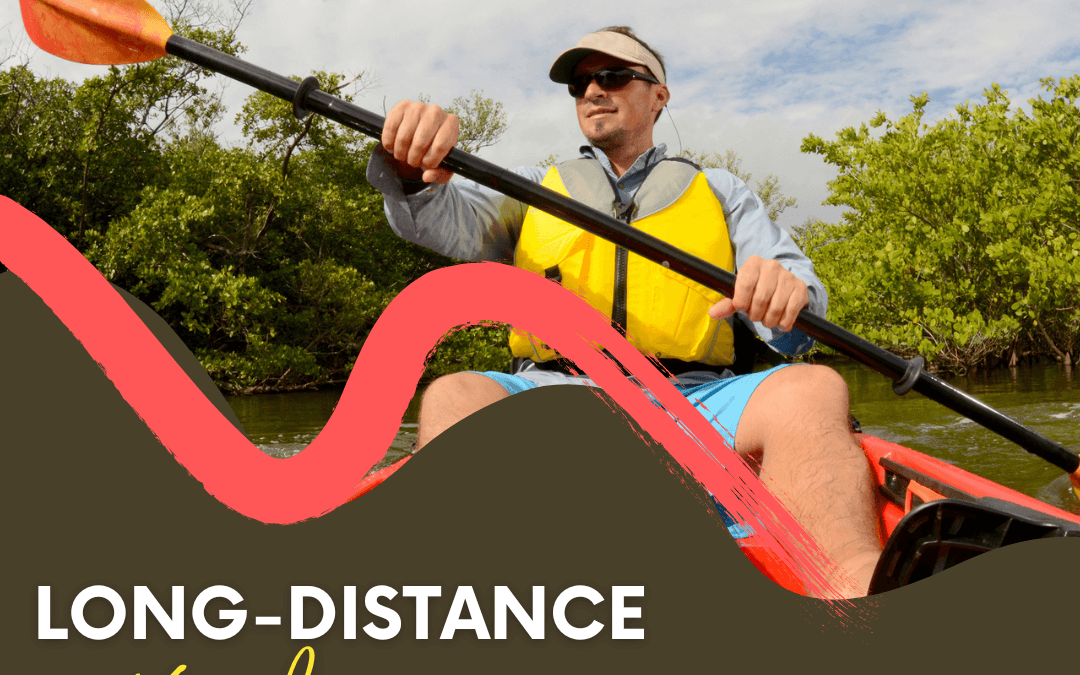==================
Florida Splendors is supported by our audience. When you purchase through one of our links, we may earn a small affiliate commission. As an Amazon Associate I earn from qualifying purchases. Your cost is not affected.
Plan a Long-Distance Kayak Trip

How to Prepare for a Long-Distance Kayak Trip?
Get in Shape
Check the Weather
It is critical to consider weather conditions when preparing for a kayaking trip. Weather conditions are one of the major factors when planning a kayaking trip. Both interior and coastal areas can experience extreme weather. All it takes is a couple of hours of heavy rain, making that gentle river a dangerous torrent.
Kayak Maintenance
Considering buying a kayak? You might find this article helpful.
Is an inflatable kayak better than a hard shell?
Plan your Long-Distance Kayak Trip Location
Flat Water
Gentle rivers and lakes comprise flat water. Flat water is excellent for starting kayakers because it has less risk and difficulty. There will be no current in the case of lakes, and the lake should be significant to merit a trip of more than a day.
White Water
Open Water
Open water sites include the ocean, large lakes, and mild rivers. Paddling on open water can be dangerous because you could be far from the land if something goes wrong. It would be best if you avoided such paddling until you undergo an advanced level of training.
Choose the Right Long-Distance Kayak Trip Group
Choose who you’ll go kayaking with when you’re getting ready for a trip. Because of the slow pace, you will likely get bored if you are a skilled paddler with a group of beginner paddlers. You will also have to pay attention to what your group is learning instead of having fun. If you have yet to paddle, don’t go with people who have. So, go with a group that works well or go alone.

Choose Your Gear for Long-Distance Kayak Trip
You will need different gear for the above paddling trips:
1. Size and Style for Long-Distance Kayak Trip
You will need a different style and size of kayak for the above destination types. The length of your kayaking trip may also determine your adventure. Your kayak choice depends on your journey. People appreciate longer kayaks because:
- These types are more maneuverable.
- They track better and follow a straight path.
- These boats have enough room to store gear on long-distance kayak trips.
These kayaks are stable, affordable, and suitable for beginners.
Touring Kayaks: These kayaks are excellent for open water and long-distance kayak trips. Also, to their ample storage space, touring kayaks perform well in waves.
Whitewater Kayaks: Because they are agile and shorter, they are suitable only if you plan a day trip. Moreover, they also have zero storage space.
Consider that hard-shell and inflatable sea kayaks are available for long-distance journeys. Each has kayak advantages and disadvantages. As a result, you should choose first. Find which has the appropriate features to meet your requirements. Some models are more comfortable to use than others. In either case, both inflatable kayaks and hard-shell ones are often long-lasting.
2. Paddle
Choosing a good paddle is a matter of budget and preference. Lightweight paddles are better. The best kayak paddles for long-distance trips should be light and sophisticated. Select a paddle and be strategic. Factors you should pay attention to include length, blade shape, and feathering angle.
3. Camping Gear
For long-distance kayak trips, you will have to bring camping gear along. In general, apply innovative hiking concepts to reduce gear weight and bulk. Some critical camping gear you should carry with you include:
- Ample water.
- Stove
- Sleeping bag and quilt.
- Shelter (tent)
- Dry bags.
- High-energy food
- Matches/ lighter
Keep in mind that the above list is only a general guide. So make sure to consider your personal needs, as there may be many other items that you want to pack.
4. Safety Equipment
Pack enough safety gear for a day or long-distance kayak trip. Your list of essential kayak safety equipment should include the following:
-
- Dry Bags to Save from Heartache: Even though it’s obvious to bring, many kayakers still need a waterproof nylon bag. They get into trouble when rough waters or rain destroy their belongings. While they don’t occupy any extra space, dry bags enable you to keep your valuables safe and dry.
- Cooler with plenty of water or other hydrating drinks and snacks. We like the CreekKooler.
- Cell Phone: During an emergency, a person’s first point of call is their cell phone. Before you set off, make sure your phone’s battery is full. You may use a few tricks to keep your phone charged on extended kayak excursions. One of the tips is to turn off your device when you’re not using it or at least turn on the power saver. It also helps to turn down the screen’s brightness and turn off WiFi, GPS, and Bluetooth. Still, avoiding apps that use a lot of power helps a lot.
- Two-Way Radio: You can use your cell phone if you go kayaking deep into the backcountry. It’s a good idea to bring two-way radios. You can stay in touch with your team and a mountain base station with a pair.
- Bilge Pump: Even the most skilled kayakers can get capsized. Rough waters, heavy winds, waves, white water, etc., can cause your kayak to dip. In such circumstances, trying to empty your kayak with a cup is a pointless exercise. So make sure to bring a bilge pump along. People have to operate a modern bilge pump by hand. Also, it fits into the bottom of the cockpit. This tip simplifies water removal.
- GPS Unit:Remember to pack a GPS unit for pinpoint accuracy when preparing for a kayak trip. You may be confident in your built-in homing device, but it is wise to fill a GPS unit. Someone on your team might have to paddle back to get help if you get hurt.
- Long-Distance Signal Devices: Two long-range communication tools are helpful for extended kayak expeditions. Practical rescue tools include air horns, flashlights, color markers, signal mirrors, and flares. But whistles and other supplies are also reliable.
- PFD (And you should wear it): A list of kayak safety equipment could only be complete if it included PFDs. PFDs (Personal Floating Devices) keep your head above water until you reach safety. Regardless of how well you can swim, all it takes is a strong wave of water to tip you out of the kayak. So, pack your PDF when preparing for a kayak trip.
- First Aid Kit: When preparing for a kayak trip, remember to review your kit to ensure it is complete. You can also consider investing in a first aid kit for boating-related injuries.
- A Map and a Compass: On some occasions, old ways work best. Technology and water rarely mix. It is sensible to only depend on your GPS device or cell phone and try to navigate with them. A map and compass can work long after your cell phone’s battery has drained.
This video provides helpful tips for planning a long-distance kayaking trip to Hana Park, including researching the route and weather conditions, packing the right gear and essentials, and considering safety measures such as wearing a life jacket and staying hydrated.
Video Credit: @WanderMediaCompany
Kayak Travel Insurance for Long-Distance Kayak Trip
Plan Your Daily Mileage
Kayaking trips for beginners can make it hard to guess how far it is sensible to paddle a day. The following are approximate daily swimming distances for beginning paddlers:
- Flatwater with no current: 20 to 15 miles.
- Flatwater (River): 15 miles.
- Open water: 20 to 15 miles.
- Whitewater: Consult with an outfitter.
These are approximate numbers; an inexperienced paddler can paddle up to 30 miles daily. But it’s important to have realistic goals. So take a few excursions with these distances. Do that until you feel ready to adjust them as you gain experience and talents.
Review and Abide LNT Guidelines
Leave No Trace (LNT) aims to help backcountry travelers plan or prepare. It also helps execute trips with minimal environmental damage. LNT principles include:
- Plan ahead and prepare.
- Camp and travel on durable surfaces.
- Dispose of the waste properly.
- Minimize campfire impacts.
- Leave what you find.
- Be thoughtful of other travelers.
- Respect wildlife.
Be Ready For Your Long-Distance Kayak Trip
That is all about how to prepare for a kayak trip. For long-distance kayak trips, take precautions to stay healthy and safe. Also, remember the LNT rules to keep the river in good shape so that other paddlers can enjoy it. Also, bringing everything on the list above will fill up every space in your kayak and weigh more than it can hold. Use a little common sense to figure out what you should pack, as you may only need some of what I have mentioned. Furthermore, consider carrying enough kayak safety equipment to mitigate the risk. Paddle on, and have fun.
Looking to kayak in Florida? Stay safe with these 10 tips on how to stay safe while kayaking, including wearing a life jacket, knowing your route, and staying aware of weather conditions. Don’t risk your safety – follow these guidelines and enjoy a worry-free kayaking experience in the beautiful Florida waters. Also, discover the ultimate adventure companion with our comprehensive AKASO underwater camera review, perfect for capturing your travel escapades in stunning detail beneath the waves.
FAQs

What time of year is best for a long-distance kayak trip?
The best time to plan a long kayak trip is when the weather, the water, and your fitness are all good. Boating in summer is great for calmer waters and warmer temps. Spring or fall is better for a more difficult cruise with cooler temps and rougher waves.
What should I bring with me on a long kayak trip?
Long kayak trips need weather-appropriate and personal equipment. Check your kayak, life jacket, paddle, camping gear, first aid kit, map, compass, clothes, food, and water. Bring a waterproof camera, fishing gear, and bug spray. Yet, for a long journey that takes days to complete, think about your storage equipment too. After all, you may need to keep your vessel on shape while you’re away from home.
How should I plan a kayak trip that lasts more than one day?
To prepare for a long-distance kayak trip, there are several important steps to take. First, it’s essential to consider the water conditions, camping options, and potential risks associated with the trip. Once these factors have been taken into account, it’s important to plan the route carefully, focusing on any areas that may be particularly risky or challenging. It’s also crucial to check local regulations and obtain any necessary permissions before setting off. Finally, it’s recommended to travel with a map, compass, or GPS to ensure that you can navigate effectively throughout your journey.
Still, think about your storage equipment too.
Read More

